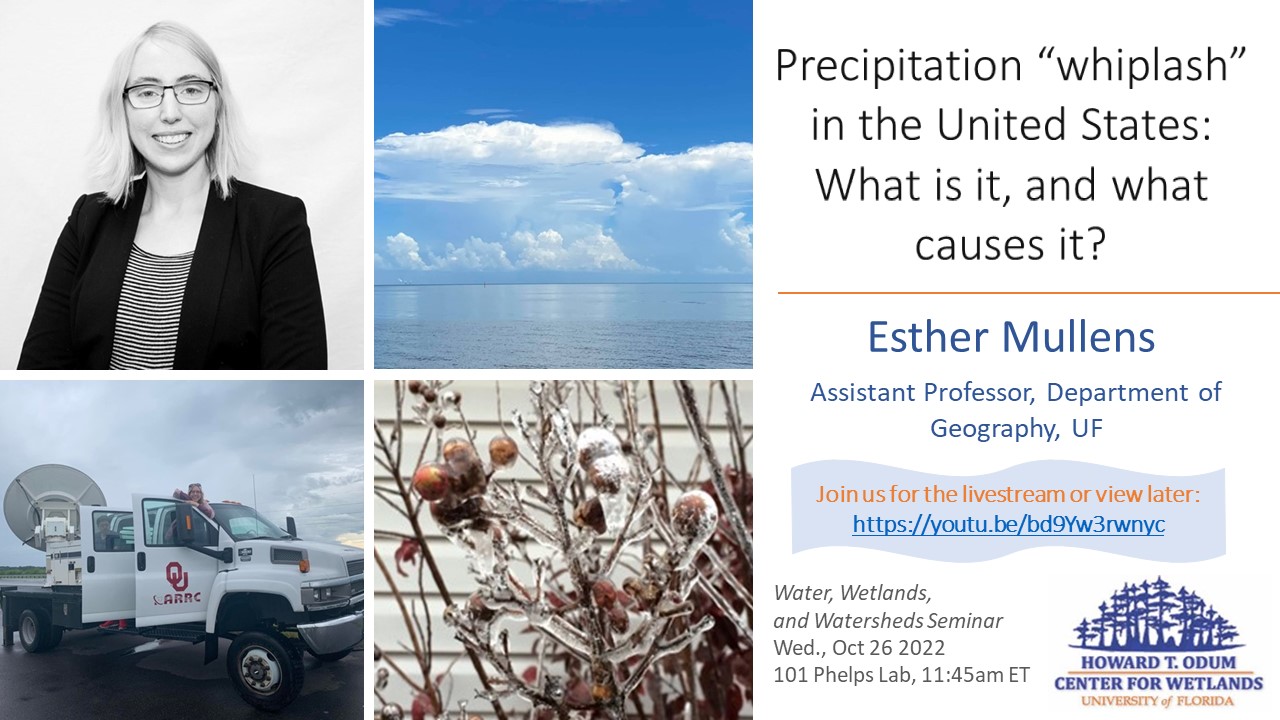
Precipitation “whiplash” in the United States: What is it, and what causes it?
Esther Mullens, Assistant Professor, Department of Geography, UF
Join us for the livestream October 26, 11:45am ET: https://youtu.be/bd9Yw3rwnyc
(Please visit our YouTube channel main page for the stream if there are any issues with the direct link.)
Abstract
Precipitation variability can be defined on many time and space scales, but one such scale of high relevance to socioecological systems is monthly-to-seasonal flips between unusually wet and dry conditions, or a ‘whiplash’ event – in reference to large swings between two opposite states. Here, a ‘whiplash’ event is defined as a month-to-month transition between total precipitation >=75th percentile (month A) and <=25th percentile (month B) or vice versa, relative to the 1981-2010 climatological normal. Frequencies and magnitudes of these events are evaluated between 1891 and 2015 across regional domains that complement the seven CONUS-based regions of the 4th National Climate Assessment. Since the occurrence of whiplash events is likely driven by anomalies in regional circulation regimes, the nature of large-scale atmospheric flow is assessed through regressing standardized warm (April-Sept) and cold (Oct-Mar) whiplash frequency statistics against standardized anomalies in critical meteorological parameters (e.g., height, winds, moisture, wave activity). Notably, some regions, such as the Northern Plains and Southeast, present circulation anomalies that resemble the EL Nino Southern Oscillation (ENSO) warm and cold phases respectively, while other locations show a mix of high-amplitude synoptic wave behavior, and other known modes of variability. In many cases, the circulation anomalies contrast with the typical climatological patterns over the respective season, indicating that whiplash events aggregated on the seasonal timescale reflect a ‘tug of war’ between climatology and a distinctly different regime(s). The results indicate that there are potentially predictable drivers of whiplash frequency, which motivates continued exploration in this topic.
BIO
Esther Mullens is an Assistant Professor of Geography at the University of Florida. She received her degrees in Meteorology from the University of Reading (UK, Bachelors), and the University of Oklahoma (PhD), followed by a postdoctoral appointment in applied climatology at the South -Central Climate Adaptation Science Center. Her research has focused on various projects related to precipitating weather systems, their evolution, and their variability and change in a warmer climate. Her PhD dissertation focused on ice storm evolution and thermodynamics in the southern plains, and more recent work has examined hydroclimate projections under climate change, precipitation variability, and operational flood forecasting. Dr. Mullens was a regional chapter author for the fourth National Climate Assessment. She enjoys translating science for broad audiences and engaging with experts outside of academia who are or plan to use climate data in their disciplines. She is one of a small team developing a new bachelor’s program in meteorology at the University of Florida.
Postcard
